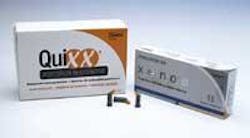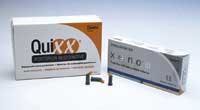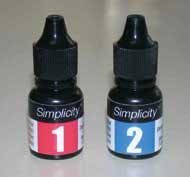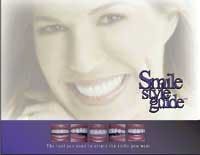Science bonds with artistry
Joe Blaes, DDS
QuiXX® posterior restorative by Dentsply Caulk. There are many new posterior composite materials on the market today. Most of them fall into the category of the new micro-hybrid composites, giving us many shades to select for the perfect aesthetic restoration. Dentsply Caulk has taken another direction with the introduction of QuiXX restorative, which offers nonsticky handling for easy adaptation to cavity walls and a unique consistency that is sculptable so you can carve anatomy before you cure. QuiXX is a highly filled composite, but it is easily extruded from a compule tip. How about speed? The technique for this composite could not be easier or faster. There is only one shade. Yes, you heard me right, one universal shade that tends to pick up color from the surrounding tooth structure. The end result is a tooth-colored restoration that offers acceptable aesthetics for posterior restorations. Here's another plus — this material offers a complete cure in only 10 seconds with a halogen or LED curing light with output of 800mw/cm2 or more. This makes QuiXX a very efficient tooth-colored restoration. Will it last? Tests for resistance to wear show good long-term results, and tests for shrinkage report a rate of 1.7 percent. Lower shrinkage should give us better marginal integrity for the long term. So, it looks like QuiXX has durability.
The technique for this new restorative material is very simple and fast. You only have one shade to worry about, and when you combine this with Dentsply Caulk's Xeno™ III single-step, self-etching adhesive, you will be amazed how quickly you can restore a posterior tooth. Polishing is quick and easy as well.
If you have struggled with composites in the past, do yourself and your patients a favor and try QuiXX restorative. Or, if you are looking for a faster, easier way to place composites, this is the one to try! I know you will be quite pleased with the results. Order from your dealer. Visit www.dentsply.com or call (800) LD CAULK (532-2855), ext. 794 for more information.
Simplicity® universal self-etch adhesive system by Apex Dental Materials. This product has been on the market for a while now but I have just recently had a chance to work with it. Simplicity was developed by Dr. John Kanca and it certainly is simple. It is what I call a two-bottle, self-etch system. Simplicity 1 combines the etchant and primer application into one simple step. Simplicity 2 is the adhesive that is applied next without any rinsing. This system can be used to seal enamel and dentin prior to restoring the tooth with light-cure or self-cure composite materials. The Simplicity system is one of the few that is recommended for use in conjunction with cementing indirect restorations with light-cured, self-cured, or dual-cured composite cements, or with glass ionomer or resin-modified glass ionomer cements. It is a great material to desensitize hypersensitive teeth and exposed root surfaces. Be sure your hygienist knows when and how to use this product. It will simplify many hygiene procedures. This is the ideal material to use when bonding posts and cores. Simplicity also is recommended for bonding veneers — making this procedure simpler than it has ever been. As with all self-etch adhesive systems, it is extremely important to carefully read and religiously follow all the instructions. All instructions for self-etch products vary – there is no universal way to use these materials. To order, call (877) APEX-123 (273-9123) or visit www.simplicityadhesive.com for more information.
The Occlusal Reduction Bur. This bur takes all the guesswork out of removing the correct amount of tooth for proper reduction. We were all taught to take a bur of known diameter and use it to make depth cuts into the inclined planes of the tooth. This standard technique rarely achieves precise occlusal reduction because these so-called inclined planes of the tooth are really concave or convex surfaces. The depth-cutting bur must be able to follow the contour of the occlusal surface to be accurate. How many times has the lab asked you to reduce an opposing tooth? This is simply because you did not give the lab enough room. The Occlusal Reduction Bur, or ORB, solves the problem with an angled, noncutting stop that allows full penetration of the cutting surface into the fissures, and the bur is able to follow the inclines with the angled stop. This unique feature allows for uniform reduction. On lower molars, place the depth cuts going in a buccal-to-lingual direction from cusp tip to cusp tip, overlapping the functional cusp. On upper molars, the more mesial depth cut should angle from the mesial buccal cusp toward the large palatal cusp. I used the 2.0 mm bur the most. The ideal reduction for a PFM crown is 2.0 mm for porcelain and coping thickness. For an all-metal crown, use the 1.5 mm or the 1.2 mm and save money on the castings. Many dentists choose to customize their kits. There are six different sizes of burs — 1.2mm, 1.5mm, 1.8mm, 2.0mm, 2.2mm, and 2.4mm. I got mine with two 1.5 mm, two 2.0 mm, and two 1.2 mm burs. This customization allows you to pick only the burs that are useful in your practice. The burs are extremely durable, providing more than 10 uses. Take the guesswork out of occlusal reduction by ordering some today. Order from the inventor, Dr. Athas N. Kometas, by calling (386) 760-0031 or visit www.occlusalrouter.com for more information.
The Lorin Library Smile Style Guide (Second Edition). If you struggle with understanding smile design, then you need to buy this book. Dr. Lorin Berland will teach you all you need to know about smile design strategy in a beautifully photographed book. Use the guide's three easy steps to help your patient choose from 18 beautiful smile designs. A fourth option illustrates the importance of determining which of the four ideal length variations of the six maxillary front teeth is best for the patient — all before you ever begin! The book is inexpensive but packed full of great information for the aesthetically oriented office. To order, call (800) 741-7966. Visit www.dallasdentalspa.com or www.digident.com for more information.




